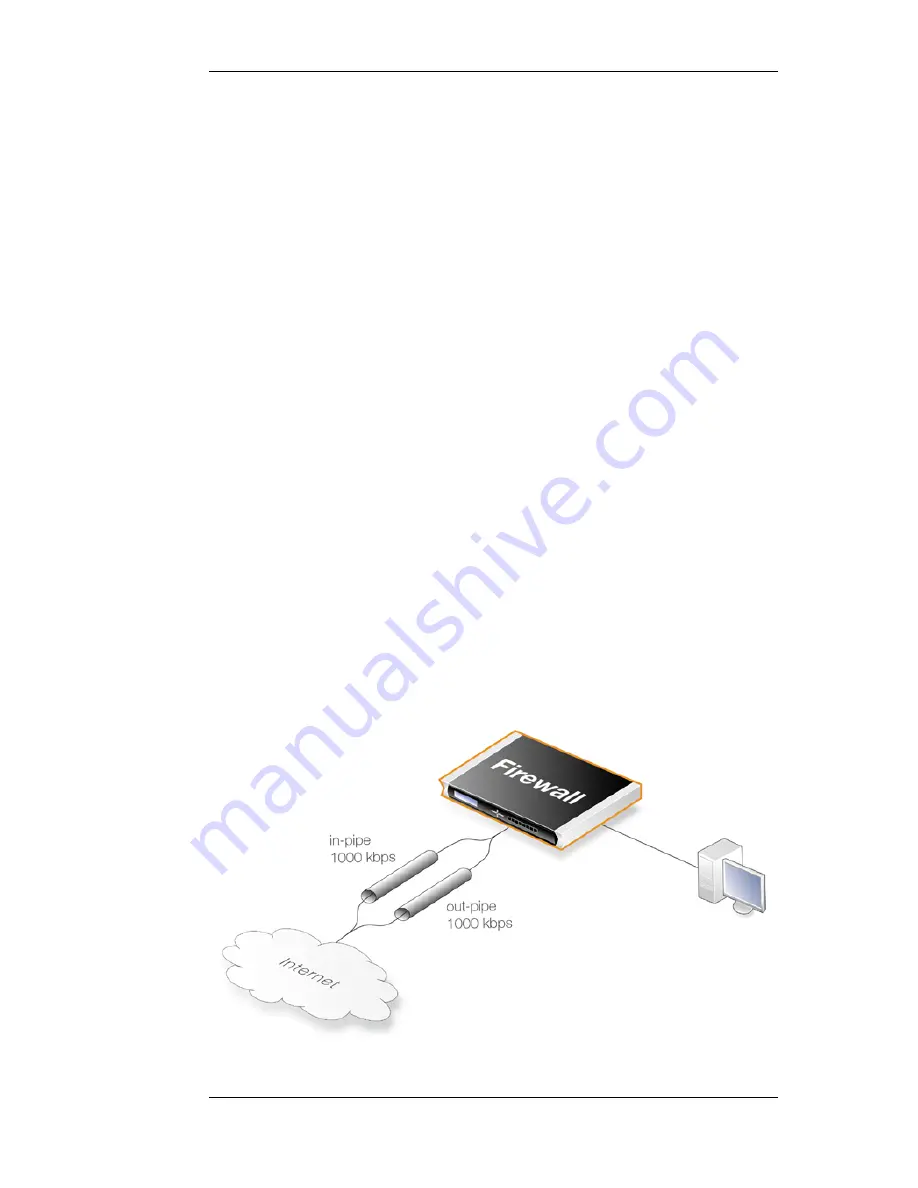
•
Select the traffic to manage through Pipe Rules.
•
Pipe Rules send traffic through Pipes.
•
A pipe can have a limit which is the maximum amount of traffic allowed.
•
A pipe can only know when it is full if a total limit for the pipe is specified.
•
A single pipe should handle traffic in only one direction (although 2 way pipes are allowed).
•
Pipes can be chained so that one pipe's traffic feeds into another pipe.
•
Specific traffic types can be given a priority in a pipe.
•
Priorities can be given a maximum limit which is also a guarantee. Traffic that exceeds this will
be sent at the minimum precedence which is also called the Best Effort precedence.
•
At the best effort precedence all packets are treated on a "first come, first forwarded" basis.
•
Within a pipe, traffic can also be separated on a Group basis. For example, by source IP address.
Each user in a group (for example, each source IP address) can be given a maximum limit and
precedences within a group can be given a limit/guarantee.
•
A pipe limit need not be specified if group members have a maximum limit.
•
Dynamic Balancing can be used to specify that all users in a group get a fair and equal amount
of bandwidth.
10.1.10. More Pipe Examples
This section looks at some more scenarios and how traffic shaping can be used to solve particular
problems.
A Basic Scenario
The first scenario will examine the configuration shown in the image below, in which incoming and
outgoing traffic is to be limited to 1 megabit per second.
10.1.10. More Pipe Examples
Chapter 10. Traffic Management
467
Summary of Contents for DFL-1600 - Security Appliance
Page 27: ...1 3 NetDefendOS State Engine Packet Flow Chapter 1 NetDefendOS Overview 27 ...
Page 79: ...2 7 3 Restore to Factory Defaults Chapter 2 Management and Maintenance 79 ...
Page 146: ...3 9 DNS Chapter 3 Fundamentals 146 ...
Page 227: ...4 7 5 Advanced Settings for Transparent Mode Chapter 4 Routing 227 ...
Page 241: ...5 4 IP Pools Chapter 5 DHCP Services 241 ...
Page 339: ...6 7 Blacklisting Hosts and Networks Chapter 6 Security Mechanisms 339 ...
Page 360: ...7 4 7 SAT and FwdFast Rules Chapter 7 Address Translation 360 ...
Page 382: ...8 3 Customizing HTML Pages Chapter 8 User Authentication 382 ...
Page 386: ... The TLS ALG 9 1 5 The TLS Alternative for VPN Chapter 9 VPN 386 ...
Page 439: ...Figure 9 3 PPTP Client Usage 9 5 4 PPTP L2TP Clients Chapter 9 VPN 439 ...
Page 450: ...9 7 6 Specific Symptoms Chapter 9 VPN 450 ...
Page 488: ...10 4 6 Setting Up SLB_SAT Rules Chapter 10 Traffic Management 488 ...
Page 503: ...11 6 HA Advanced Settings Chapter 11 High Availability 503 ...
Page 510: ...12 3 5 Limitations Chapter 12 ZoneDefense 510 ...
Page 533: ...13 9 Miscellaneous Settings Chapter 13 Advanced Settings 533 ...






































